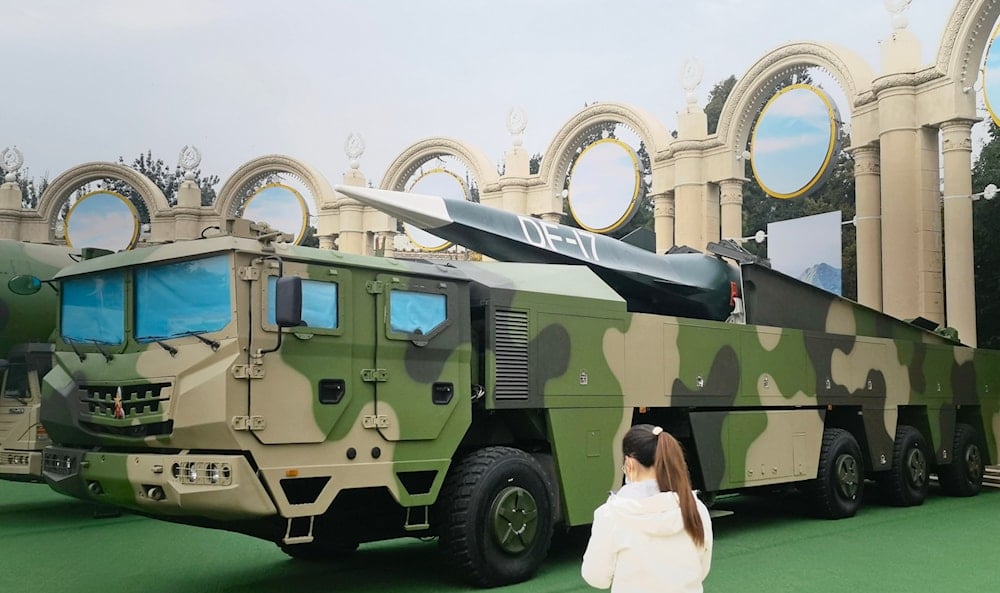ODE ignites at Mach 8: China revives forgotten US jet tech
The test marks a breakthrough in aerospace propulsion technology and positions China ahead in the race for military hypersonic weapons.
-

A DF-17 hypersonic missile transporter-erector-launcher featured in the "New Era Achievements" exhibit at Beijing Exhibition Hall, Beijing, China (Wikimedia Commons)
A team of Chinese researchers, supported by the government, recently announced a breakthrough in testing a new type of hypersonic engine, putting it ahead of the US on the hypersonic frontier, the Eurasian Times reported on Sunday, citing the South China Morning Post.
A state-backed Chinese research team recently published a peer-reviewed article in the Chinese-language Journal of Aerospace Power detailing a successful ground test of an oblique detonation engine (ODE) chamber that utilized RP-3 aviation kerosene.
Instead of using specialized fuel like hydrogen, this engine operates on regular jet fuel, which is cheaper and more readily available.
Breakthrough military test
This experimental study was conducted collaboratively by researchers from the China Academy of Launch Vehicle Technology (CALT), the country's leading aerospace propulsion institute, and Northwestern Polytechnical University, with their findings published in the journal on May 6, 2025.
The researchers reported that the experiment successfully validated the concept's technological feasibility for military use by achieving ignition and sustaining stable detonation waves for over two seconds while simulating flight conditions at Mach 8 (eight times the speed of sound) and an altitude of 30 kilometers.
A previous assessment conducted in February by the China Airborne Missile Academy had determined that a ground test sustaining detonation for more than one second would be required to demonstrate sufficient reliability for military adoption of ODE technology in operational weapon systems.
The ODE concept, initially developed by University of Michigan researchers through a US Air Force-funded project in 1958, offers a propulsion system that eliminates moving parts by merging combustion with shock waves.
How ODE works
This type of engine, including the Oblique Detonation Wave Engine (ODWE), is a promising option for ultra-fast hypersonic flight, since it creates intense shockwaves that instantly mix and ignite fuel with air in a compact space, instead of using traditional combustion methods.
This design makes the engine shorter, lighter, and more efficient at extreme speeds compared to conventional scramjet engines, while also reducing the need for heavy cooling systems.
Flying with reduced air resistance possible
The technology's ability to function effectively even with lower pressure at the engine's intake could enable the aircraft to fly with reduced air resistance, which may decrease the intense heat and structural stress experienced by the vehicle's body during high-speed flight.
In December 2024, a team led by the Chinese Academy of Sciences achieved a 50-millisecond kerosene-fueled detonation in a Mach 9 wind tunnel, though critics initially dismissed this as merely a laboratory achievement due to its extremely short duration.
These doubts have now been challenged by the recent CALT-led test, which not only lasted 40 times longer but also demonstrated observable and stabilized detonation waves, as highlighted in the SCMP report.
Chinese scientists achieve another breakthrough
The research team, headed by scientist Yang Yang, reported in their peer-reviewed paper that the flame stayed consistently controlled during the entire 2.2-second test period, demonstrating that liquid-fueled oblique detonation engines can indeed work as designed when the fuel is injected directly into the combustion chamber.
The paper acknowledges several remaining challenges alongside its progress, for instance, fuel only occupied 39% of the 90 mm-high flow channel, creating uneven distribution in outer sections, while pressure fluctuations in the exhaust sometimes disrupted wave stability, prompting the team to propose potential fixes like redesigning the injector and extending the fuel-air mixing pathways.
Though the development of an ODE-powered hypersonic airliner capable of shortening the Shanghai to San Francisco journey to just one hour remains a project requiring many more years of research and testing, the report suggests that military applications of this technology could potentially be realized on a much faster timeline.

 4 Min Read
4 Min Read









